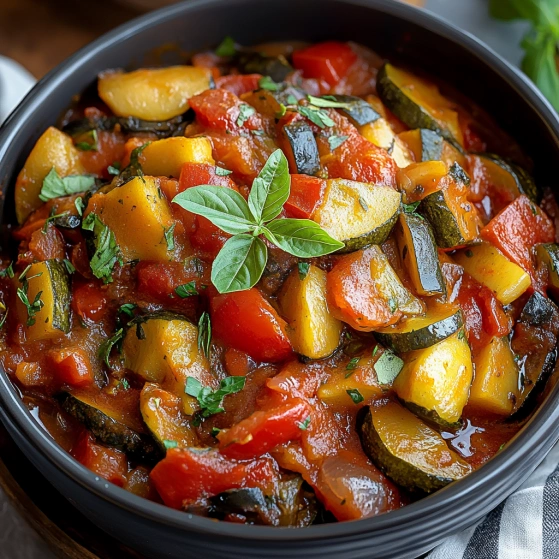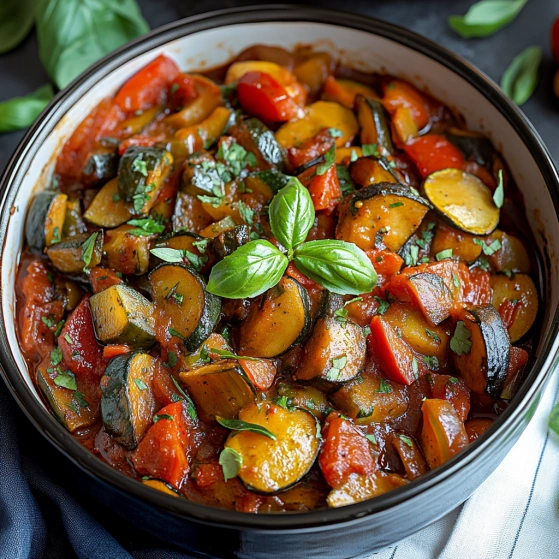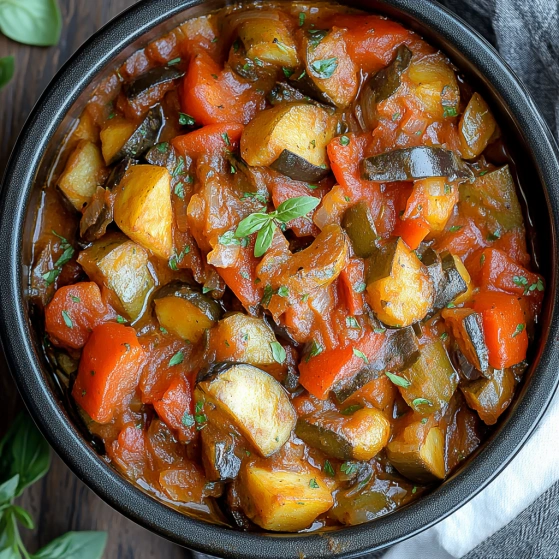 Pin it
Pin it
Slow Cooker Ratatouille transforms humble vegetables into a rustic French countryside dish with minimal effort. This traditional Provençal stew combines Mediterranean vegetables that melt together during the slow cooking process, creating rich flavors that deepen over time. The beauty of this dish lies in its simplicity—just chop your vegetables, toss them in the slow cooker, and let time work its magic while you go about your day.
I first made this ratatouille when I had an abundance of summer vegetables from my garden. My family was heading out for the day, and I wanted something healthy waiting for us when we returned. The house smelled absolutely divine when we walked through the door, and my picky teenager even asked for seconds!
Key Ingredients and Selection Tips
- Eggplant: Choose firm, glossy eggplants with no soft spots. The smaller ones typically have fewer seeds and less bitterness. No need to peel for this recipe—the skin adds color and nutrition.
- Zucchini: Look for medium-sized zucchini with bright, unblemished skin. Overly large ones can become watery and less flavorful.
- Bell Pepper: Any color works beautifully, though red adds sweetness and vibrant color. Select peppers with smooth, firm skin and no wrinkles.
- Onion: Yellow onions provide the perfect balance of sweetness and savory depth. Make sure they're firm with no sprouting.
- Garlic: Fresh cloves yield the best flavor. Choose heads that are firm with tight skin.
- Canned Tomatoes: The undrained tomatoes provide essential moisture. Fire-roasted varieties can add an extra layer of flavor.
- Olive Oil: Use a good quality extra virgin olive oil for the most authentic Mediterranean flavor.
- Herbs: Dried herbs work perfectly in the slow cooker, but fresh basil at the end brightens everything up.
Step-by-Step Cooking Instructions
- Step 1:
- Take your time with vegetable preparation as uniform sizes will ensure even cooking. Dice the eggplant into 1-inch cubes (no need to salt and drain for slow cooking). Slice zucchini into half-moons about 1/2-inch thick. Core and chop the bell pepper into roughly 1-inch pieces. Dice the onion and mince the garlic finely—these aromatic ingredients will infuse throughout the dish.
- Step 2:
- Rather than simply dumping everything in, consider layering for best results. Start with onions and garlic on the bottom where they'll have direct contact with the heating element. Next add bell pepper, followed by eggplant and zucchini. This strategic arrangement helps manage moisture release during cooking.
- Step 3:
- Pour the undrained diced tomatoes over your vegetable layers. Drizzle olive oil evenly across the top. Sprinkle with dried thyme, dried basil, salt, and freshly cracked black pepper. The dried herbs will rehydrate during cooking, releasing their essential oils throughout the dish.
- Step 4:
- Cover with the lid and set your slow cooker to low for 6-8 hours. This gentle, extended cooking time allows the vegetables to slowly release their flavors and meld together. If you're short on time, high setting for 3-4 hours works too, but the low setting develops more complex flavors and maintains better texture in the vegetables.
- Step 5:
- About 30 minutes before serving, gently stir the ratatouille and taste for seasoning, adjusting salt and pepper if needed. Leave the lid slightly ajar for the final cooking time if you'd like to reduce excess liquid. Just before serving, tear fresh basil leaves over the top for a burst of color and freshness.
 Pin it
Pin it
I'm particularly fond of the eggplant in this dish. My grandmother used to grow these beautiful purple gems in her garden, and I was skeptical as a child. But when slowly cooked like this, eggplant transforms into a creamy, almost meaty component that absorbs all the surrounding flavors. My husband, who claimed to hate eggplant for years, now specifically requests "that slow cooker dish with the eggplant" at least twice a month.
Serving Suggestions
Ratatouille's versatility makes it a true kitchen workhorse. Serve it straight from the slow cooker alongside crusty whole grain bread for sopping up the flavorful juices. The dish makes an excellent bed for a poached egg at brunch, creating a complete protein-rich meal that will sustain you for hours. For dinner parties, I've served it slightly chilled as an appetizer on toasted baguette slices with a small dollop of goat cheese, which always impresses guests with minimal additional effort.
Storage and Repurposing
This ratatouille keeps beautifully in the refrigerator for up to five days, with flavors that continue to develop and improve. Store in airtight glass containers to prevent staining and preserve freshness. Don't hesitate to make a double batch—the leftovers transform wonderfully into new meals throughout the week. I often blend leftover ratatouille with vegetable broth for a quick soup, stir it into beaten eggs for a rustic frittata, or use it as an incredibly flavorful pasta sauce with a sprinkle of parmesan.
 Pin it
Pin it
Seasonal Adaptations
While traditional ratatouille features summer vegetables, this recipe adapts beautifully to seasonal variations year-round. In winter, incorporate hearty root vegetables like turnips or parsnips for a more substantial stew. Spring ratatouille welcomes tender asparagus and early zucchini during the last hour of cooking. Fall versions can include chunks of butternut squash or a handful of sliced mushrooms for earthier notes. The cooking method remains the same, but these thoughtful substitutions keep the dish relevant and exciting throughout the changing seasons while always honoring its Provençal roots.
Frequently Asked Questions
- → Can I use fresh tomatoes instead of canned?
Yes, you can substitute fresh tomatoes for canned. Use around 2-3 medium tomatoes, diced, and add a bit of extra water if needed for moisture.
- → Can I make this dish on the stovetop?
Absolutely! Simply sauté the vegetables in olive oil, add the herbs and tomatoes, and simmer on low heat until the vegetables are tender, about 30-40 minutes.
- → What can I serve with this vegetable medley?
This dish pairs well with crusty bread, rice, quinoa, or couscous. You can also serve it as a side with grilled proteins.
- → How can I store leftovers?
Store leftovers in an airtight container in the refrigerator for up to 3-4 days. Reheat gently on the stovetop or in the microwave.
- → Can I freeze this dish?
Yes, you can freeze the vegetable medley. Allow it to cool completely, transfer to a freezer-safe container, and freeze for up to 3 months. Thaw in the refrigerator overnight before reheating.
